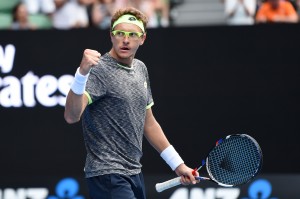By Randy Walker
@TennisPublisher
Whether it is for the Australian Open or for the $15,000 USTA Futures event in Vero Beach, Florida, wild card events are becoming more and more a fabric of professional tennis.
Wild cards, or entries into professional tennis tournaments for players who do not qualify on ranking, were (and still are) often only subjectively awarded to players by tournament directors, coaches and administrators from the tennis governing body for the respective nation. Sometimes wild cards are awarded to big-name players who do not previously enter the tournament, so as to enhance ticket sales and excitement in a tournament field. Controversy often follows wild card selections as players – and coaches, parents and observers – make arguments why someone should or should not have received this free tournament invitation.
Roger Federer, who has not needed a wild card into a tournament since he was a junior player, is still in touch with the complexities and sensitivities to wild card selections.
“It’s like at a wedding — where do you make the cut?” he said in 2015. “It’s like there shouldn’t be one, but unfortunately there has to be one. I feel like it’s similar. It’s just annoying, you know?”
To avoid controversies and to provide for additional competitive playing opportunities where players actually EARN their wild card positions, more and more tournaments are instituting wild card tournaments, where the winner will be awarded the wild card invitation to the event. This also prevents any argument as to whether one player or another is more deserving of a wild card selection – it is settled on the court!
The Australian Open hosts two wild card tournaments, one exclusively for Australian players and another for players from Asian nations (held in China) so as to more closely associate the tournament as the Grand Slam of Asia Pacific.
Curiously, one of the winners of these wild card tournaments, the Asian wild card tournament winner Denis Istomin, became the story of the tournament with his upset of No. 2 seed and six-time event champion Novak Djokovic in the second round. At the same time as Istomin’s upset, on the other end of the spectrum of the tennis world, 36 men competed in another wild card tournament on the other end of the planet in Key Biscayne, Florida. They, however, were fighting in another wild card tournament to earn a main-draw entry into the $15,000 USTA Pro Circuit “Futures” level tournament, the Mardy Fish Children’s Foundation Tennis Championships, to be played April 21-30 in Vero Beach, Florida.
Junior Alexander Ore, a 24-year-old from Maryland and a former standout from Texas A&M University, rightly earned his right into the main draw of the Vero Beach Futures by defeating Brazil’s Felipe Frattni 6-4, 6-2 in the final.
The Key Biscayne wild card tournament is the first four different wild card events for the Vero Beach Futures, for which I serve in the role as co-tournament director. We are allowed two main draw singles wild cards for Futures events and the second wild card event is tentatively scheduled for Vero Beach in late February – likely in between USTA Pro Circuit events in Orlando and Indian Harbor Beach, Florida. Even in doubles, the wild cards will be earned with a doubles wild card event being scheduled to be played simultaneously as the singles qualifying event April 21-24, using the FAST4 modified scoring system. Our final doubles wild card event will be determined in a popular local Vero Beach doubles tournament series called “King of the Hill.”
While these wild card events do provide players with the opportunity to earn their spots, providing extra competitive opportunities to test their physical and mental skills that will help serve them down the road, they also have other purposes. For the Mardy Fish Children’s Foundation Tennis Championships, all the profits for the event benefit the non-profit foundation that benefit children in Indian River County, Florida. The wild card events become additional revenue streams for the Foundation as, under a deal struck with the wild card tournament directors, half of the entry fees go to the Foundation.
These wild events – whether it’s the Australian or U.S. Open or a USTA Pro Circuit Futures event – also provide opportunities to pre-promote an event for sponsors and fans. For the Australian Open, they can promote the Australian Open brand in China with their Asian wild card event. The USTA have a nationwide wild card event for the U.S. Open called the “U.S. Open National Playoffs” where the winners of 17 sectional tournaments throughout the year play in a wild card tournament to determine who will receive a wild card into the U.S. Open qualifying tournament.
For our Key Biscayne wild card event, we can take advantage of the larger player base in the Miami area to gain more tournament entries (36 players in this wild card event was the most we had had) and also to further expose the Mardy Fish Children’s Foundation brand (www.MardyFishFoundation.com) to the South Florida audience.
In 2016, we hosted two singles wild card tournaments – one at the Disney ESPN Wide World of Sports in Orlando and the other at Ballen Isles resort in Palm Beach Gardens, Florida. The Disney event also featured a doubles wild card tournament, The wild card singles final at Disney featured one the greatest final of a wild card event ever played at any level as 18-year-old Adam Ambrozy of Florida beat former Colombian Davis Cup John Medina 6-4, 6-7, 6-2 in an incredible 3 hours, 20 minutes under the hot Florida on the slow clay center court that used to host the U.S. Men’s Clay Court Championships. Not only did Ambrozy rightfully earn his position in our 2016 draw, but gained an amazing, confidence-building experience in winning a grueling singles final against a seasoned veteran player.

